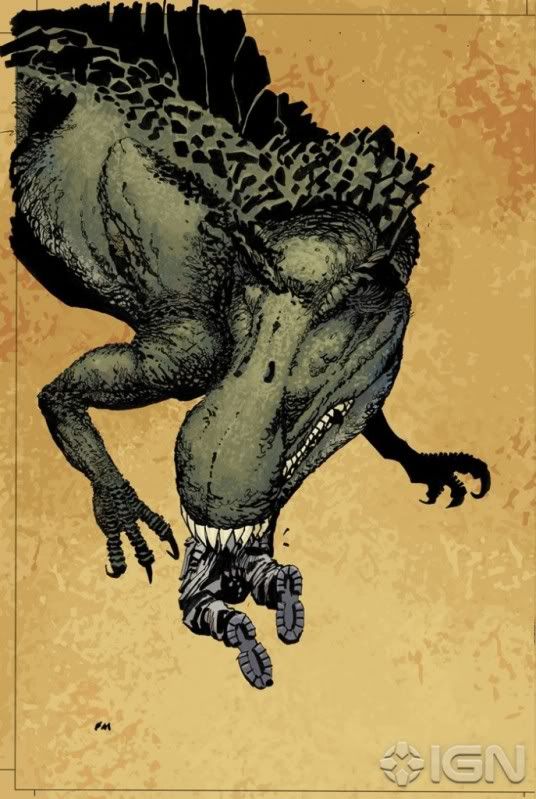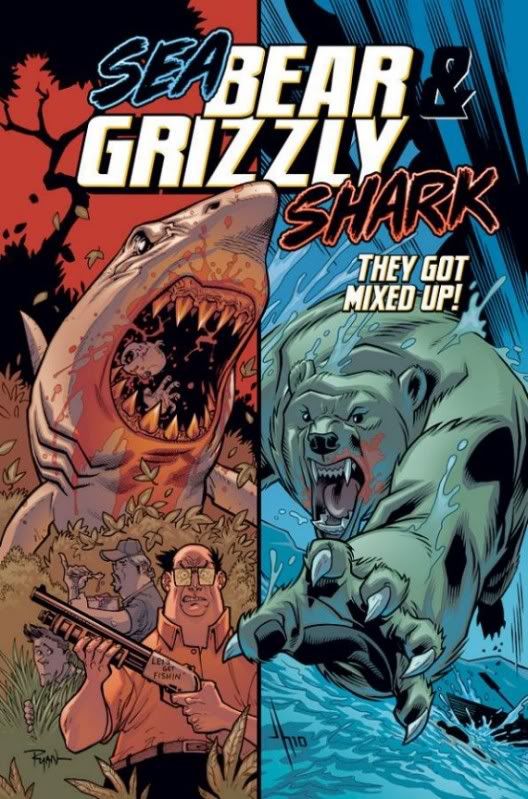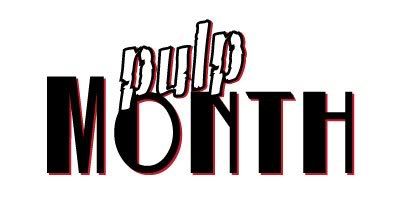
p. 35:
King Conan Volume One: The five over-sized issues of
King Conan in this book are my favorite Conan comic of all time. From a person that once ran a Conan comic website, that is strong praise. Everyone should read it.
p. 79:
Batman Beyond #1: Terry McGinnis returns in comic form. I have no idea how good this book will be, but the return of the future Batman is definitely reason to celebrate.
p. 87:
The Spirit #3 and
Doc Savage #3: It’s Pulp Month here, so I think its would be best to cover these two new pulp-oriented ongoings. The first issues hit in the next couple weeks so be sure to check them out.
p. 107:
Tom Strong and the Robots of Doom #1: It is without original co-creator Alan Moore, but Chris Sprouse’s always gorgeous art returns to Tom Strong. Peter Hogan wrote the amazing
Terra Obscura for the ABC line, so I think this book has tons of potential to be a really great sleeper hit, Alan Moore or not.

p. 140:
Jurassic Park #1: IDW moves to the front of the catalog and this book leads it off. I am not sure how big a deal a new
Jurassic Park comic really is, but this will certainly be an interesting read. The concept takes the movie through real time and makes Tim and Lex Murphy the now adult leads. Should be interesting to see how this one plays out. And the Frank Miller dinosaur cover doesn’t hurt either (though I am pretty sure it comes from an old JP card set and isn’t original to this book.)
p. 173:
Hack/Slash: My First Maniac #1:
Hack/Slash has definitely had its ups and downs as a series, but with a move to Image, this book should be sitting in a lot more solid place for many months to come. If you enjoy slasher movies, you should definitely be reading this book, as it gives an interesting new and heroic twist to the genre.
p. 174:
Dynamo 5: Sins of the Father #1: I am a huge fan of Jay Faerber’s little corner of the Image universe. While his artists are now working over at DC, he has teamed with Julio Brilha to bring back
Dynamo 5 in limited series form. And to up the fun, he has brought in
Invincible’s Omni-Man and Rob Liefeld’s
Supreme to up the ante! This one should be a lot of fun and I highly recommend it.
p. 180:
Brigade #1: Speaking of Rob Liefeld, here he has the return of Brigade! I always liked the team even through the pains of their original limited series, only to see them all slaughtered in the ongoing book. Here, Liefeld teams with the original artist Marat Mychaels to reboot the concept. Say what you will about Liefeld, but I am on-board for this one.

p. 181:
Sea Bear & Grizzly Shark: Let’s just let the cover do the talking for this one.
p. 189:
God Complex #7: I don’t think I have mentioned this well-written new book by Daniel Berman, John Broglia, and Mike Oeming yet. The basic concept is simple: Apollo decides to stop being a god and live as a mortal. Zeus and the rest of the family become less than happy about it. And the adventure begins! A great fun book that never takes itself too seriously. Anyone who enjoys fun comics should give this one a try.
p. M19:
Deadpool: Wade Wilson’s War #1 & 2: Normally I am not much of a fan of Marvel’s current Deadpool titles. But you get Jason Pearson on art and my opinion can quickly change. This book is sure to be beautiful, even though the solicitations don’t really clear up what it is about. I think it is supposed to be his origin story, but I guess we will have to wait and see.

p. M27:
Spider-Ham 25th Anniversary Special #1: I do not know what is more amazing. Is it the return of Peter Porker, Spider-Ham? Or is it the Joe Jusko cover it is wrapped in?
p. M31:
Avengers Academy #1: I have no idea how this book differs from the original concept of
Avengers: The Initiative, but I am happy to see it has new characters and excellent art by Mike McKone. Could be a winner.
p. M51:
Hawkeye & Mockingbird #1: I am more of an indy comics buyer, but Marvel has guaranteed I will regularly be buying at least two of their regular titles with this book.
Atlas was already a guaranteed sell, and I am nothing if not an unrepentant Hawkeye fanboy. Jim McCann wrote a pretty decent limited for these two last year and this one has the potential to be a great book as well. And it has Crossfire and Phantom Rider!
p. 218:
The Royal Historian of Oz #1: While I don’t know the names Tommy Kovac or Andy Hirsch, I can’t argue with a new Oz comic for only a buck. Amaze Ink has me for at least one issue with this one.

p. 218:
Shadoweyes: Also from Amaze Ink this month is a new graphic novel featuring the beautiful art of Ross Campbell. Campbell has previously drawn the gorgeous
Wet Moon and
The Abandoned, so I am guessing this future superhero tale will almost certainly be gorgeous.
p. 250:
Pale Horse #1: One of my biggest complaints about Boom as a publisher is their lack of previews. While I am curious to learn more about this Western tale of an ex-slave, previews are nowhere to be found. Michael Alan Nelson has been more miss than hit for me as a writer, so I am going to pass it up. Hopefully I am not missing out on a good book do to bad marketing.
p. 252:
Darkwing Duck: The Duck Knight Returns #1: On the other hand, Boom’s other new book pretty much sells itself. Darkwing Duck has a definite cult following and should make a big splash at Boom. Now if they can just get the continuance of Greg Weisman’s
Gargoyles....
p. 290:
Ghostopolis: Doug TenNapel, creator of Earthworm Jim, has produced some great comics over the last few years like
Earthboy Jacobus and
Iron West. He has left Image for his latest OGN, a kids book called
Ghostopolis. It looks like an interesting dark fantasy, which isn’t typical kiddy fare, but neither was Harry Potter a little over a decade ago.

p. 292:
Unfabulous Five: The Greasers From the Black Lagoon #1: Humanoids is back to self-publishing in America and part of the deal is the return of this great series (formerly part of Image’s
Lucha Libre anthology) to print. Hilarious pseudo-super hero tales of washed-up luchadores. What more can you ask for?
p. 300:
Super Pro K.O.! volume 1: It is an unwritten rule that wrestling comics fail. They fail hard. But this cartoony, over the top series by Oni Press might actually manage to make wrestling comics cool.
p. 324:
Battle Smash vs. Saucer Men From Venus: And wrestling may be a them of this month’s previews with this lucha superhero series from Viper Comics.

p. 337:
Alter Ego #94 and
Back Issue #41: Two new issues of Twomorrow’s great comic history magazines. And they both now feature sixteen color pages, which ups their greatness that much more.
Back Issue is a guaranteed buy from me ever six weeks, while this issue of
Alter Ego looks good as it continues the magazine’s look at DC’s Earth Two.
p. 369:
Tarot: Witch of the Black Rose Minimates boxed set: This may be the officially oddest Minimate set ever.
p. 388:
Tonner Tomb Raider: Amanda Evert Doll: I haven’t played a Lara Croft game in years, but when did she get an evil goth enemy? And now that figure has a Barbie-style doll!
That’s it for this month. We will leave you with one last terrifying look at the Tarot minimates.















